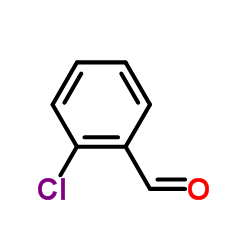Percutaneous absorption of 14C-labelled 2-chlorobenzaldehyde in rats. Metabolism and toxicokinetics.
E C Rietveld, R M Hoet, F Seutter-Berlage, J M Van Rossum
Index: Eur. J. Drug Metab. Pharmacokinet. 13(4) , 231-40, (1988)
Full Text: HTML
Abstract
2-Chlorobenzaldehyde might be produced when a moist skin is exposed to the riot control agent CS. CS-hydrolysis to 2-chlorobenzaldehyde and malononitrile occurs both in vitro and in vivo. No quantitative data have thus far been reported with respect to the percutaneous absorption and the cutaneous biotransformation of 2-chlorobenzaldehyde. Percutaneous absorption, biotransformation and elimination of 14-C-labelled 2-chlorobenzaldehyde was investigated in the rat. Following IV (25 microliters/kg) and IP (37.5 microliters/kg) 14C-2-chlorobenzaldehyde administration to rats, the plasma radioactivity declined rapidly over a 24 h period with similar plasma radioactivity-time profiles. Following cutaneous administration (75 microliters/kg) in a closed glass-cup on the skin a slow skin penetration occurred as indicated by plasma radioactivity levels. A slow increase in plasma radioactivity was followed by a slow decline of radioactivity in plasma over a 3-day period. Most of the radioactivity was found in the urine with low levels in faeces and exhaled air. The cutaneously administered radioactivity was also partly recovered from the glass-cup. For the qualitative and quantitative determination of metabolites in urine, a thin layer chromatography-radioautography method was used. The metabolic patterns of urinary excreted metabolites following cutaneous application and systemic administration of 14C-2-chlorobenzaldehyde to rats were very similar. No parent compound was recovered from the rat urine. 2-Chlorohippuric acid was the principal urinary metabolite. Quantitatively, the urinary excretion of 14C-2-chlorobenzyl alcohol following cutaneous application differed substantially from that after the systemic administration. There was no evidence of storage in the skin or skin toxicity of 2-chlorobenzaldehyde following cutaneous application.
Related Compounds
| Structure | Name/CAS No. | Molecular Formula | Articles |
|---|---|---|---|
 |
2-Chlorobenzaldehyde
CAS:89-98-5 |
C7H5ClO |
|
Acetalization allows the photoheterolysis of the Ar-Cl bond ...
2012-10-19 [J. Org. Chem. 77(20) , 9094-101, (2012)] |
|
Experimental and theoretical studies of the products of addi...
2015-07-01 [Acta Crystallogr. C Struct. Chem. 71 , 554-63, (2015)] |
|
β-Olefination of 2-alkynoates leading to trisubstituted 1,3-...
2011-07-01 [Org. Lett. 13(13) , 3418-21, (2011)] |
|
Vibrational spectra of partially oriented molecules having t...
2005-05-01 [Spectrochim. Acta. A. Mol. Biomol. Spectrosc. 61(7) , 1661-70, (2005)] |
|
Analysis of the aneuploidy inducing capacity of 2-chlorobenz...
1991-07-01 [Mutagenesis 6(4) , 303-5, (1991)] |